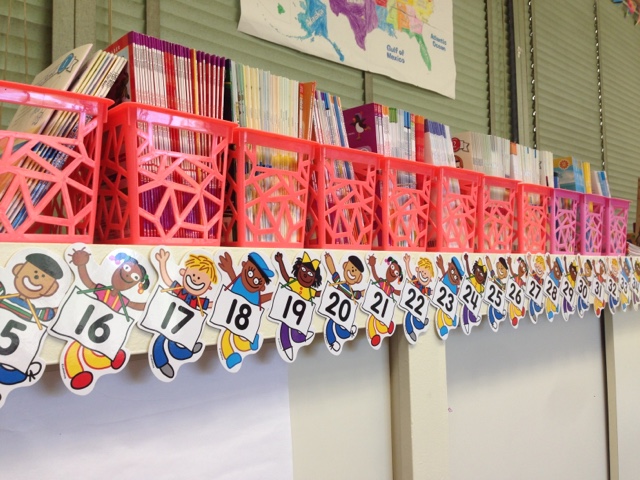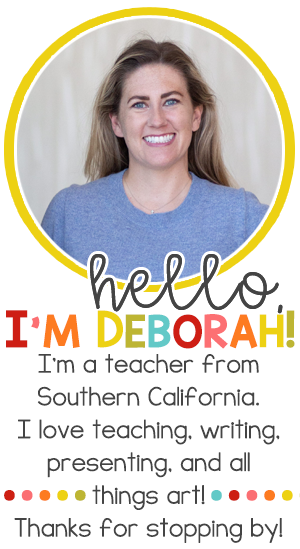Go Shopping:
✏︎ Composition books in specific colors (green for math, yellow for spelling) from Target ($0.50 apiece)
✏︎ Student Work folders (from whichever office supply store has them on sale the cheapest)
✏︎ Primary Writing Journals from Dollar Tree ($1.00 apiece)
✏︎ Extra boxes of Crayola Crayons and Glue Sticks (because we always need extra)
✏︎ Rolls of fadeless bulletin board paper from Lakeshore
✏︎ Rolls of corrugated borders from Lakeshore
✏︎ Name plates for desks
✏︎ New birthday poster
✏︎ New "Who lost a tooth?" poster
✏︎ ALL THE THINGS in the Target Dollar Spot 😉
✏︎ Stress balls for students who may need help calming themselves down
(I usually also buy myself a new set of colorful Sharpies, and a new box of my favorite pens, regardless of how many I have stashed in a tub in my classroom already. Just because it makes me happy.)
Once I Have My Class Roster:
★ Update class website with students' birthdays
★ Write names on Birthday Poster
★ Pre-Write names on Happy Birthday certificates (keep in a page protector and hang next to
Birthday poster)
★ Create Star of the Week calendar/schedule
★ Update class website with students' Star of the Week date assignment
More Getting Ready:
✓ Prepare Math Journals:
⚬ Pre-number pages (odd pages only)
⚬ Affix ruler tape to cover
✓ Prepare Spelling Journals:
⚬ Stamp top corners of pages with letter stamps
⚬ Cut dividers from card stock, glue inside
Classroom Set Up & Decoration
✏︎ New "Who lost a tooth?" poster
✏︎ ALL THE THINGS in the Target Dollar Spot 😉
✏︎ Stress balls for students who may need help calming themselves down
(I usually also buy myself a new set of colorful Sharpies, and a new box of my favorite pens, regardless of how many I have stashed in a tub in my classroom already. Just because it makes me happy.)
Once I Have My Class Roster:
★ Update class website with students' birthdays
★ Write names on Birthday Poster
★ Pre-Write names on Happy Birthday certificates (keep in a page protector and hang next to
Birthday poster)
★ Create Star of the Week calendar/schedule
★ Update class website with students' Star of the Week date assignment
★ Update ClassDojo with students' names
★ Create/look up student accounts for online programs:
- Spelling City
- Read Theory
- Accelerated Reader (AR)
- Mathletics
★ Create labels for workbooks and journals:
- Writing Journals
- Math Journals
- Spelling Journals
- Math Workbook
- Handwriting Workbook
- ELA Workbook
★ Create labels for filing tabs (for completed work bin)
★ Write names on desk name plates
★ Write names on die-cuts for Welcome Back bulletin board
★ Create new Class Jobs board with students' names
★ Print and laminate website password cards
- Writing Journals
- Math Journals
- Spelling Journals
- Math Workbook
- Handwriting Workbook
- ELA Workbook
★ Create labels for filing tabs (for completed work bin)
★ Write names on desk name plates
★ Write names on die-cuts for Welcome Back bulletin board
★ Create new Class Jobs board with students' names
★ Print and laminate website password cards
★
More Getting Ready:
✓ Prepare Math Journals:
⚬ Pre-number pages (odd pages only)
⚬ Affix ruler tape to cover
✓ Prepare Spelling Journals:
⚬ Stamp top corners of pages with letter stamps
⚬ Cut dividers from card stock, glue inside
Classroom Set Up & Decoration
✓ Plan theme/color scheme
✓ Put up bulletin board paper and borders
✜ Star of the Week
✜ Calendar
✜ Welcome Back to School
✜ Religion
✓ Arrange desks and tables depending on class size
✓ Clean tops and insides of desks
✓ Number desks with Sharpie Paint Pens
✓ Pull textbooks out of cabinet, lay on corresponding numbered desk
✓ Hang bunting banners across windows
✓ Hang "Lost a Tooth" & Happy Birthday poster
✓ Prep classwork folders with highlighters (see my post HERE on how I do this)
What do YOU do to get yourself ready for
the first week of school???








































